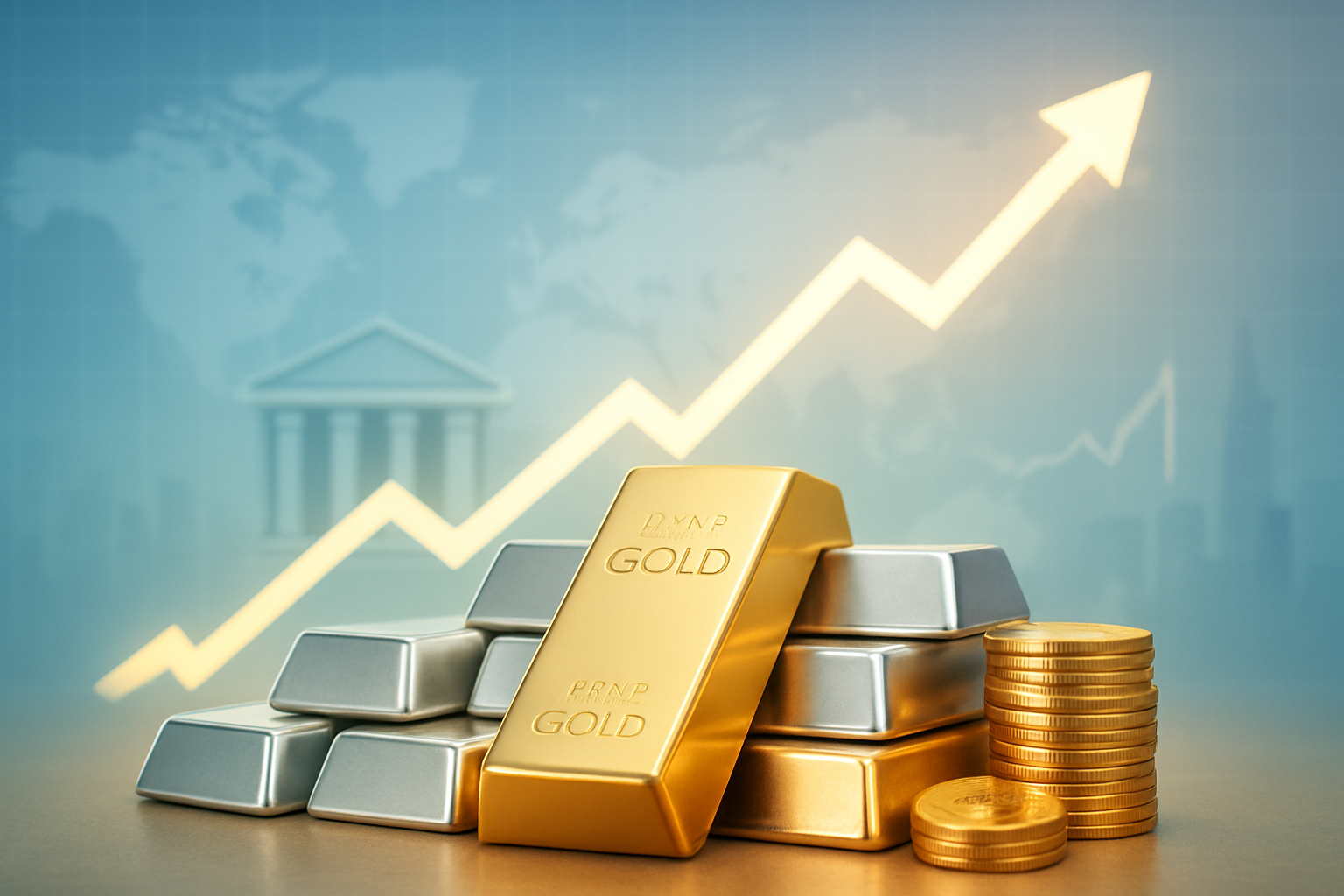
As November 2025 draws to a close, the financial markets are witnessing a remarkable surge in the prices of gold and silver, with spot gold poised for its fourth consecutive monthly gain and spot silver skyrocketing to fresh all-time highs. This sustained rally in precious metals is largely attributed to mounting expectations of a dovish shift in the Federal Reserve's monetary policy, prompting investors to flock to safe-haven assets amidst a backdrop of economic uncertainty and anticipated lower interest rates. The immediate implications are significant, signaling a potent "flight to safety" and presenting substantial opportunities for companies involved in the precious metals sector.
The current trajectory of gold and silver prices underscores a pivotal moment for investors and market participants. With the prospect of a more accommodative monetary policy from the Federal Reserve, the opportunity cost of holding non-yielding assets like gold and silver diminishes, making them increasingly attractive. This dynamic is not only reshaping investment strategies but also highlighting the enduring role of precious metals as hedges against inflation and economic volatility.
A Surge Fueled by Shifting Monetary Tides
The precious metals market has been a hive of activity throughout November 2025, culminating in impressive gains. Spot gold has seen an increase of over 2% for the week, on track for a monthly rise between 3.9% and 4.6%. Over the past month, gold's price has risen 7.14%, contributing to a nearly 60% year-to-date increase, potentially marking its best annual performance since 1979. Gold prices have been robust, trading around $4,160 to $4,197 per ounce, having peaked at an all-time high of $4,381.58 in October.
Spot silver, however, has delivered an even more explosive rally in percentage terms, reaching new all-time highs above $55 per ounce in London trade on November 28, 2025. Specific reported highs include $54.76 and $55.08 per ounce. This surge eclipses its previous October peak of $54.50. Silver is currently heading for its fifth consecutive session of gains and its biggest weekly gain since late May, with an impressive year-to-date increase exceeding 81%, significantly outperforming gold. For the week, silver was up 7.8%.
The timeline of events leading up to this moment reveals a clear correlation with evolving Federal Reserve sentiment. Throughout 2025, the Federal Reserve has already initiated a series of rate cuts, including reductions in September and October that brought the federal funds rate to a target range of 3.75% to 4.0%. This ongoing easing has laid the groundwork, but the recent acceleration in precious metal prices is directly linked to escalating expectations for further dovish action. Market traders are now pricing in a high probability, between 80% and 90%, of an additional 25-basis-point interest rate cut by the Federal Reserve at its upcoming December 9-10 meeting. This sharp increase in dovish expectations follows recent dovish comments from prominent Federal Reserve officials, including New York Fed President John Williams and Fed Governor Christopher Waller, alongside underwhelming U.S. economic data, such as softer labor market readings.
Key players involved in this scenario include the Federal Reserve, whose policy decisions are the primary catalyst; global investors, who are reallocating capital into precious metals; and the various entities in the precious metals supply chain. Initial market reactions have been overwhelmingly positive for precious metals, while the U.S. dollar has weakened, heading for its biggest weekly drop since late July, making dollar-denominated commodities more attractive to international buyers. This divergence highlights the immediate impact of shifting monetary policy expectations on currency and commodity markets alike.
Companies Poised to Win or Lose from the Precious Metal Boom
The sustained rally in gold and silver prices presents a bifurcated landscape for public companies, creating significant opportunities for some while posing challenges for others. Companies directly involved in the extraction, processing, and trading of precious metals are undoubtedly the primary beneficiaries.
Mining giants stand to gain substantially. Companies like Barrick Gold (NYSE: GOLD) and Newmont Corporation (NYSE: NEM), two of the world's largest gold producers, will likely see improved revenue streams and profitability. Higher commodity prices directly translate to increased margins on their extracted metals, assuming production costs remain stable. This can lead to enhanced earnings per share, stronger balance sheets, and potentially increased dividends for shareholders. Silver miners such as Pan American Silver Corp. (NASDAQ: PAAS) and First Majestic Silver Corp. (NYSE: AG) are experiencing an even more dramatic upside, given silver's record-breaking performance. Their asset valuations are expected to rise, attracting further investor interest and capital.
Beyond mining, companies involved in precious metals refining, fabrication, and investment vehicles also stand to benefit. Firms offering gold and silver-backed exchange-traded funds (ETFs) and other investment products will likely see increased inflows as investors seek exposure to the booming market. This includes fund managers and financial institutions that facilitate trading in these commodities. The increased trading volume also benefits commodity exchanges and brokerage firms.
Conversely, companies heavily reliant on physical demand for gold and silver, particularly in the jewelry and industrial sectors, might face headwinds. While investment demand is robust, the high prices are simultaneously cooling physical demand for jewelry and bars in key Asian markets like India and China. Manufacturers of high-end jewelry or industrial components that use silver might see a contraction in demand or be forced to absorb higher input costs, potentially squeezing their profit margins. Furthermore, companies with significant exposure to a strong U.S. dollar could indirectly face challenges as the dollar weakens against other major currencies, though this effect is more nuanced and dependent on their specific operational geographies and revenue streams.
Broader Significance and Historical Context
The current rally in gold and silver fits squarely into broader industry trends emphasizing safe-haven assets and inflation hedges in an uncertain global economic environment. The market's pivot towards precious metals reflects a collective investor sentiment that anticipates not only lower interest rates but also potential economic slowdowns or persistent inflationary pressures. This trend has been building over several months, with central banks globally accumulating gold, further signaling its role as a reserve asset.
The ripple effects of this event extend across various sectors. For competitors, particularly other commodity markets, the strength in precious metals could draw capital away, potentially impacting prices in industrial metals or energy sectors. Partners within the precious metals supply chain, from exploration companies to logistics providers, will likely experience increased activity. Regulatory bodies will be closely monitoring market volatility and potential speculative activities, though no immediate policy implications beyond existing frameworks are anticipated.
Historically, periods of sustained precious metals rallies have often coincided with shifts in monetary policy and economic anxieties. For instance, the late 1970s saw a similar surge in gold prices during a period of high inflation and geopolitical instability, while the post-2008 financial crisis era also witnessed a strong rally as central banks engaged in quantitative easing. The current situation draws parallels to these historical precedents where dovish central bank policies, coupled with economic uncertainty, diminished the real returns on traditional fixed-income assets, making non-yielding precious metals more appealing. The year-to-date increase in gold, potentially marking its best annual performance since 1979, underscores this historical resonance.
The ongoing supply constraints for silver, particularly the reported decade-low inventories in China, amplify its price increase and highlight a structural component to its rally beyond purely monetary policy expectations. This scarcity, combined with robust inflows into bullion-backed ETFs, suggests a more fundamental re-evaluation of silver's value.
What Comes Next: Navigating the Future of Precious Metals
Looking ahead, the short-term trajectory for gold and silver prices will largely depend on the Federal Reserve's actions at its upcoming December 9-10 meeting and subsequent communications. If the Fed indeed delivers the anticipated 25-basis-point rate cut and maintains a dovish tone for 2026, precious metals are likely to sustain their upward momentum. Short-term possibilities include further price appreciation as more investors reallocate capital in anticipation of continued easing. However, any unexpected hawkish signals or stronger-than-expected economic data could temper the rally, leading to profit-taking.
In the long term, the outlook for precious metals remains robust, particularly if the broader macroeconomic environment continues to be characterized by lower growth, persistent inflation, or geopolitical tensions. Precious metals could solidify their position as core components of diversified investment portfolios. Potential strategic pivots for mining companies might include accelerating exploration and development projects to capitalize on higher prices, while investors might consider increasing their exposure to precious metals ETFs or physical bullion.
Market opportunities could emerge for innovative financial products that offer hedged exposure or leverage to precious metal movements. Conversely, challenges might arise from increased regulatory scrutiny on commodity markets if volatility becomes excessive, or from potential supply responses if sustained high prices incentivize new production. Potential scenarios range from a continued "goldilocks" environment for precious metals, where rates remain low and inflation moderate, to more volatile outcomes if global economic conditions deteriorate sharply or if central bank policies diverge from current expectations.
Comprehensive Wrap-up: A New Era for Precious Metals
The sustained rally in gold and silver, driven by dovish Federal Reserve expectations, marks a significant turning point in the financial markets as of late 2025. Key takeaways include gold's impressive fourth consecutive monthly gain and silver's astonishing ascent to fresh record highs, both fueled by the prospect of lower interest rates and a weakening U.S. dollar. This phenomenon underscores the enduring appeal of precious metals as safe-haven assets and hedges against economic uncertainty and inflation.
Moving forward, the market will remain highly sensitive to Federal Reserve communications and macroeconomic data. Investors should closely watch for the outcome of the December FOMC meeting and any forward guidance regarding future rate cuts. The interplay between monetary policy, inflation expectations, and global economic stability will continue to dictate the direction of gold and silver.
The lasting impact of this event could be a re-entrenchment of precious metals in mainstream investment strategies, shifting from a niche asset class to a more central role in portfolio diversification. For companies in the mining sector, this period offers a chance to bolster financials and expand operations. For the broader public, it highlights the tangible effects of central bank policy on everyday investments and the cost of goods. What investors should watch for in coming months includes the actual pace of Fed rate cuts, inflation trends, and any shifts in geopolitical stability, all of which will serve as critical indicators for the continued performance of gold and silver.
This content is intended for informational purposes only and is not financial advice





